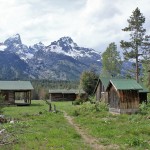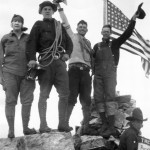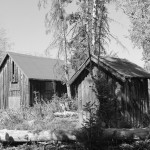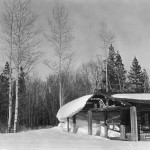LUCAS ERA: 1913-1938
Geraldine Lucas was born November 5, 1866 in Iowa. In 1885, she married Michael O’Shea and became pregnant with a son. After two years of an unhappy marriage, Geraldine left O’Shea and legally reclaimed her maiden name for both herself and her son, Russel. As a single mother she attended Oberlin College in Ohio. After graduating in 1889, she moved to New York City where she found work as a teacher. She taught art, music and sewing until 1912 when she retired. At this point, she followed two brothers and a sister and moved to Jackson Hole, Wyoming in 1913.
There she filed for a 160 acre homestead and after several years of bureaucratic hurdles, her application was approved for 159.97 acres. Soon after, she applied for 38 acres of land on Phelps Lake under the Timber & Stone Act. Geraldine was never seriously interested in agriculture or farming. She cultivated the land according to the law and abandoned the practice soon after her application was approved. She made the necessary improvements to the property, but rarely undertook any manual labor other than gardening and general maintenance. Her improvements included a 5-room log cabin, a store house, hen house, rabbit house, buck pole & wire fence and two drainage ditches. The original cabin was later joined by what she termed “Russell’s Cabin.” This building was a single story log structure, with 5 rooms. These included 2 bedrooms, 2 bathrooms, a living room and space for a kitchen, should it later prove necessary to add one on. One of the bathrooms was fitted with a tub and a toilet, despite the property having no plumbing.
Russell would visit his mother once a year, but never for more than a week and he never stayed in his cabin. He saw no value or use for the remote property, but was nonetheless a caring son. Geraldine had saved enough money from her teaching in New York for a comfortable retirement. Russell also had successful career in the Coast Guard and would often send his mother money to supplement her savings. Her cabin had no electricity or plumbing and she made her own clothing. She had very little need for money. She did, however, amass a very large reading collection. At the time of her death, she had 1,353 books. These books would sustain her during the long winter months that she often referred to as her hibernation. The only concession she made towards modern amenities was to have a pitcher pump installed in her mud room. This would provide her with water during the long months when Cottonwood Creek was frozen. The creek runs only a handful of feet from her cabin, which made water collection a simple task.
Along with her vast library, which she split up between her three cabins, she had collected a strange variety of possessions over her life. Her son returned from a trip to Alaska bearing a walrus and polar bear skull, along with the walrus tusks. He also brought her a Siberian Eskimo pipe and a Kodiak bear taxidermy head. She had a coyote head and pelt, along with several antlers that she found in the woods near her house. She owned and played the piano, two violins and a clarinet.
Geraldine was a very active lady, and pursued many outdoor activities. During the summer months she kept a horse and would often go riding. Her son Russell, wanting to make sure she could remain mobile during the winter, provided her with a sled and team of dogs. The dogs remained with her year-round while the horse was sent to her brother’s ranch near Spring Gulch. She also housed a 1924 Buick touring car in a garage, which she would take out on nice days. Few people in the valley had cars due to the rough terrain and lack of bridges over many creeks and rivers. Geraldine’s own property required a bridge to be built, as Cottonwood Creek meanders through the entrance road. After a chance encounter with a 16-year old Paul Petzoldt, who later became a famous mountaineering guide and founder of the National Outdoor Leadership School (NOLS). Petzoldt was commencing his first ascent of the Grand from her property, Geraldine convinced him to guide her to the summit. Geraldine Lucas climbed the Grand Teton on August 2, 1924. She was 58 years old and the second recorded woman to have made the climb. This was Petzoldt’s second ascent.
Around 1918, Geraldine met Naomi Brewster Colwell, another single woman who had come to the valley. She persuaded Colwell to take up a homestead directly to the south of her own property. In 1922, Colwell’s application was approved for 160 acres. She promptly sold her land to Geraldine and moved back home to Michigan. Hiring other homesteaders to increase your land was a popular process. Colwell never lived on her own property, she instead lived in a cabin that was built for her by Geraldine. After Colwell’s departure, Geraldine used this cabin as her summer kitchen and storage space. During the long winters, Geraldine would remain in her own cabin and blocked off extra rooms to save heat.
Around the end of the 1920s, the Snake River Land Company (SRLC) was buying land in the Jackson Hole Valley. This was a secret operation undertaken by John D. Rockefeller, Jr. in order to preserve the valley for the eventual incorporation of a national park. If the land owners knew that a Rockefeller was interested in their land, the prices would skyrocket. So Rockefeller started the SRLC, and set one of his lawyers, Harold Fabian, as the man in charge of buying up different parcels. Almost immediately, the rumors started. Soon it became generally known that the land was being purchased to give back to the Federal government in some form. Many of the residents of Jackson Hole were incensed by this practice, as they had had no part in the decision making process. Many of them had moved to this area specifically for the public land prospects and the rights to owning your own tract of land. Hard work and great personal risk went into filing, proving up and maintaining their homesteads and the idea that it could all be undone with a pen stroke was unthinkable. Others were concerned about losing grazing rights to large tracts of federal lands. Fears and emotions ran even higher in 1927 when Calvin Coolidge signed Executive Orders #4685 which closed over 23,000 acres of public lands in Jackson Hole to homesteading. With this Order, the homesteading era was effectively over in the valley. In 1929, Coolidge signed Grand Teton National Park into existence. The original borders contained the Teton Range along with several small lakes at its base, excluding Jackson Lake. With the new national park bordering her property, Geraldine was certainly nervous.
While many people supported the national park plans and sold their homesteads, many more were steadfastly remaining. Geraldine’s location directly underneath the Grand, just south of the Jenny Lake recreation area meant she had prime land to save from development. She stood up to Fabian for years, refusing to sell to the Federal government. Due to her earlier bureaucratic struggles in receiving her homestead patent, she severely mistrusted the federal government. Fabian made several offers, well above the appraisal value of her land and she still refused. She quickly became one of the biggest opponents in the valley, holding out much longer than many of the others on her side.
She was known for being rather eccentric, whether by nature or by her several years spent living alone. As she aged, Geraldine would start to make demands on Fabian and try to strike up certain deals in order to ensure her property was preserved after she was gone. Among her ideas were to preserve her property for the President’s vacationing and recreation use. She wanted the current President to come out to meet her and see her property, as she was convinced he would not be able to turn her down. Later she started scheming to donate the land to Oberlin College. Unfortunately, despite all of her grandiose ideas, Geraldine Lucas lost her fight on August 12, 1938 when she died of heart failure.
Her son Russell quickly had her property and belongings assessed, and sold the lot to J.D. Kimmel later that month on August 31, 1938. Russell had no use for the property, and never held much value in its location or appeal. Despite having purchased Geraldine’s personal property, Russell reportedly unceremoniously dropped all of it into a nearby cesspool. Despite being a loving son, he certainly held no love for his mother’s possessions. He did, however, demonstrate that he understood the importance of this place to his mother. He found a boulder on the northwestern edge of her property in the meadow that faces the Grand Teton and buried his mother’s ashes in a large crevice in the center. He ordered a large plaque that still sits there today, commemorating her memory and burial location. There was no mention of her siblings’ involvement with her estate appraisal and sale.
FABIAN ERA: 1945-1982
J.D. Kimmel, owner of the store, gas station and Kimmel Kabins at Jenny Lake, also had his eye on Geraldine Lucas’s land for years. Kimmel had big plans to subdivide the homestead and sell the lots off as housing units. This would allow a continual flow of guests to his concession up at Jenny Lake. Whether by accident or purpose, Fabian and Kimmel developed a friendship. They struck up a deal that would ensure that Geraldine’s biggest fear would never come to pass. The Jackson Hole Preserve, Inc. (formerly the Snake River Land Company) bought all of Kimmel’s land at Jenny Lake, including the Lucas Homestead. This would be a key part of the process in preserving these areas, and saving them from the development that Kimmel was planning.
In 1945, shortly after the Jackson Hole Preserve, Inc. had obtained the Kimmel holdings, Harold Fabian was instructed to take up residence at the Lucas homestead. This was seen as an unofficial headquarters for the Jackson Hole Preserve, Inc. Fabian would regularly entertain politicians, dignitaries and several other important men during the summers. He and his wife Josephine lived here during mid-June through mid-September. Josephine kept a full social calendar, often throwing large dinner parties for visiting and local guests. She kept track of all those who she had hosted through a unique system. Each guest would receive a simple wooden clothes pin as a place card at their spot around the large dining room table, along with the dates of their visit. If they returned, new dates were added. For those no longer in use, she strung them up around the walls of the dining room to show off the most important visitors.
The Fabians were allowed to stay here on a lease that ran through the next 25 years, until September of 1975. They did not own their summer property, but acted as caretakers for the buildings. While they would do very little in the way of manual labor, they made many changes to the way the homestead was run. They added electricity, plumbing, sewage facilities and a telephone line, constructed a powerhouse which housed a Kohler plant for electricity, dug a well and added a pump house to provide running water.
Harold and Josephine moved into Russell’s cabin, making use of the larger spaces and the bathrooms that were connected to the new plumbing system. They fixed up and maintained all of the buildings that Geraldine Lucas had built, making very little structural changes. They hired a couple to cook, clean and keep the ranch in running order. They also added a barn with corrals to stable horses that they would obtain from the nearby Jenny Lake concession. Naomi’s cabin was moved closer to the original cluster of buildings and it was renovated into a bunkhouse. Geraldine’s cabin was used as a dining hall and kitchen, and her old bedroom housed the seasonal caretakers.
Things were run very differently from the years that Geraldine Lucas had occupied the homestead. Geraldine preferred the quiet and solitude the location offered. She seldom went into town and lived a happy solitary life, content to keep her property to herself. The Fabians, however, believed the ranch should be welcoming and enjoyed by everyone. They regularly hosted locals, as well as US Presidents and politicians. They also invited their family and friends from home, keeping up a constant stream of visitors throughout the summer.
In September of 1975, the same month their original lease was set to expire, Harold Fabian had a heart attack and was flown out of the valley to a local hospital. He would linger for months before dying on December 7. Despite their lease having expired, Josephine continued to spend her summers on the ranch for the next few years. Her final summer was in 1981, and in 1982 she returned briefly to pack up her belongings and say goodbye. She died on December 20, 1984.
TIMELINE
1913: Geraldine Lucas applies for 160 acre homestead.
1914: Geraldine applied for 38 acres on Phelps Lake under Timber & Stone Act. This land was not adjacent to her homestead.
1918: Geraldine continued to prove up on her homestead application, enduring several bureaucratic hurdles. Many were boundary line disputes resulting from Geraldine not having her property surveyed a second time.
*In order to prove up: Geraldine plowed 20 acres, grew wheat until a 1914 hail storm in July and switched to timothy hay and alfalfa. She also built a 5-room (only 3 rooms, pantry and mudroom may have also been included in her tally) log cabin, store house, hen house, rabbit house, granary, buck pole & wire fence and 2 irrigation ditches.
*Geraldine never had any real intentions of ranching or farming, she only cultivated what was necessary by law and abandoned the practices soon after receiving her patent.
*She did, however, have a garden directly across from her house in Cottonwood Creek on a small island.
1922: Received final approval on her application after the boundary line disputes were settled. She was officially approved for 159.97 acres rather than the original 160.
1922: Another single woman named Naomi Brewster Colwell was passing through the valley when she met Geraldine Lucas. Geraldine convinced Colwell to apply for a 160 acre tract of land directly south of her own land, and to prove up and receive her patent. Colwell complied, and after having her application approved, she sold her land to Geraldine and moved back home.
*Geraldine’s land now totaled 319.97 acres, not including the 38 acres she had on Phelps Lake.
1923: Geraldine applied for 80 more acres under the Desert Land Act.
1924: On August 2, Geraldine Lucas becomes the second recorded woman to climb the Grand. She was 58 years old, and a 16-year-old Paul Petzoldt was her guide.
1927: Geraldine received 70.03 acres after more bureaucratic filing problems. This was the last application she would submit for land. Her homestead how totaled 399.97 acres, plus the 38 acres on Phelps Lake.
1938: Geraldine Lucas dies on August 12. Her son buried her ashes in a large boulder, sealed with a plaque. The boulder is located on the northwestern edge of her property, facing the Grand.
1938: On August 31, J.D. Kimmel purchased Geraldine’s land from her son, Russell. Her belongings were reportedly also part of this transaction, but Russell apparently threw them into a nearby cesspool.
1944: J.D. Kimmel was befriended by Harold Fabian (lawyer to Rockefellers and Snake River Land Company) sold the property to the SRLC. The SRLC had changed its name to the Jackson Hole Preserve.
1946: Harold and Josephine Fabian spend their first summer at the homestead. They would return mid-June to mid-September every year for the next 29 years.
1975: Harold dies on December 7th, after having been medevaced out of the valley in September. Josephine would continue to return after Harold’s death until 1981. In 1982 Josephine returned to gather her belongings and never returned. She later died on December 20, 1984.
Text by Samantha Ford, Director of Historical Research and Outreach





